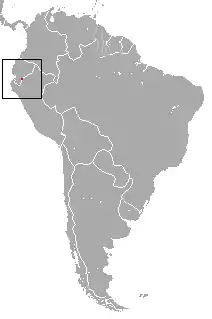| Andean caenolestid | |
|---|---|
| Scientific classification | |
| Domain: | Eukaryota |
| Kingdom: | Animalia |
| Phylum: | Chordata |
| Class: | Mammalia |
| Infraclass: | Marsupialia |
| Order: | Paucituberculata |
| Family: | Caenolestidae |
| Genus: | Caenolestes |
| Species: | C. condorensis |
| Binomial name | |
| Caenolestes condorensis Albuja and Patterson, 1996 | |
 | |
| Range of C. condorensis | |
The Andean caenolestid (Caenolestes condorensis), also known as the Andean shrew opossum or Condor caenolestid, is a shrew opossum known only from Cordillera del Cóndor (Ecuador), its type locality. It was first described by zoologists Bruce D. Patterson and Luis Albuja in 1996. It is the largest caenolestid. The IUCN classifies it as vulnerable. As of 2015, the population is estimated at less than 1,000.
Taxonomy and etymology
The Andean caenolestid is one of the five members of Caenolestes, and is placed in the family Caenolestidae (shrew opossums).[2] It was first described by zoologists Bruce D. Patterson (of the Field Museum of Natural History) and Luis Albuja (of the National Polytechnic School) in 1996 from an adult male specimen captured from Cordillera del Cóndor (Ecuador). They procured a total of three specimens.[3]
In the latter part of 20th century, scientists believed that Caenolestes is closely related to Lestoros (the Incan caenolestid).[4][5] Over the years, it became clear that Lestoros is morphologically different from Caenolestes.[6] A 2013 morphological and mitochondrial DNA-based phylogenetic study showed that the Incan caenolestid and the long-nosed caenolestid (Rhyncholestes raphanurus) form a clade sister to Caenolestes. The cladogram below is based on this study.[7]
| |||||||||||||||||||||||||||||||||||||||||||||||||
Caenolestid fossils date to as early as the early Eocene (nearly 55 mya). The generic name Caenolestes derives from the Greek words kainos ("new") and lestes ("robber", "pirate").[8] The specific epithet condorensis is based on the name of the type locality, Cordillera del Cóndor.[3] It is also known by the name 'Condor caenolestid'.[6]
Description
Patterson and Albuja identified the Andean caenolestid as the largest in its family. It is characterized by large, heavy canines, long rostrum (nearly 2 cm (0.79 in) long), massive skull (nearly 3.8 cm (1.5 in) long), whitish whiskers, dark brown coat, and a dark spot on the chest. The mean external measurements recorded from the three specimens were as follows: the total length was 26 cm (10 in), the weight was 48 g (1.7 oz), the tail was 13 cm (5.1 in) long, the hindfeet measured 3 cm (1.2 in) and the ears 1.8 cm (0.71 in). Sexual dimorphism is prominent, with males larger than females.[3]
Distribution and status
The Andean caenolestid is known only from Cordillera del Cóndor, which is located in the eastern Andes.[6] The locality is characterized by ash deposits dating to the Cretaceous, vegetation less than 1.5 metres (4.9 ft) in height and bromeliads (locally known as "achupallas"). The specimens were captured on the ecotone (interface) between the short grassy vegetation of the plateau and the higher, wooded slopes.[3] The IUCN classifies it as vulnerable. As of 2015, the population is estimated at less than 1,000.[1]
References
- 1 2 Solari, S.; Martínez-Cerón, J. (2015). "Caenolestes condorensis". IUCN Red List of Threatened Species. 2015: e.T136743A22180165. doi:10.2305/IUCN.UK.2015-4.RLTS.T136743A22180165.en. Retrieved 19 November 2021.
- ↑ Gardner, A.L. (2005). "Order Paucituberculata". In Wilson, D.E.; Reeder, D.M (eds.). Mammal Species of the World: A Taxonomic and Geographic Reference (3rd ed.). Johns Hopkins University Press. p. 19. ISBN 978-0-8018-8221-0. OCLC 62265494.
- 1 2 3 4 Luis, A.V.; Patterson, B.D. (1996). "A new species of northern shrew opossum (Paucituberculata: Caenolestidae) from the Cordillera Del Condor, Ecuador". Journal of Mammalogy. 77 (1): 41–53. doi:10.2307/1382707. JSTOR 1382707.
- ↑ Simpson, G.G. (1970). "The Argyrolagidae, extinct South American marsupials". Bulletin of the Museum of Comparative Zoology. 139: 1–86.
- ↑ Marshall, L.G. (1980). "Systematics of the South American marsupial family Caenolestidae". Fieldiana: Geology. New Series. 5: 1–145.
- 1 2 3 Gardner, A.L., ed. (2007). Mammals of South America. Vol. 1. Chicago, US: University of Chicago Press. pp. 121, 124–6. ISBN 978-0-226-28242-8.
- ↑ Ojala-Barbour, R.; Pinto, C.M.; Brito M., J.; Albuja V., L.; Lee, T.E.; Patterson, B.D. (2013). "A new species of shrew-opossum (Paucituberculata: Caenolestidae) with a phylogeny of extant caenolestids". Journal of Mammalogy. 94 (5): 967–82. doi:10.1644/13-MAMM-A-018.1.
- ↑ Patterson, B.D.; Gallardo, M.H. (1987). "Rhyncolestes raphanurus" (PDF). Mammalian Species (286): 1–5. doi:10.2307/3503866. JSTOR 3503866. S2CID 253944594.
External links
 Data related to Caenolestes condorensis at Wikispecies
Data related to Caenolestes condorensis at Wikispecies
